令和4年8月20日(土)、東京都は、SDGsを楽しく学べる都民向けイベント「【わかる!今日からできる!】夏のSDGsの集い」を開催いたしました。ぜひ、このページを使って、今日からできるSDGsの取組のヒントを知り、今日から実践してみましょう!
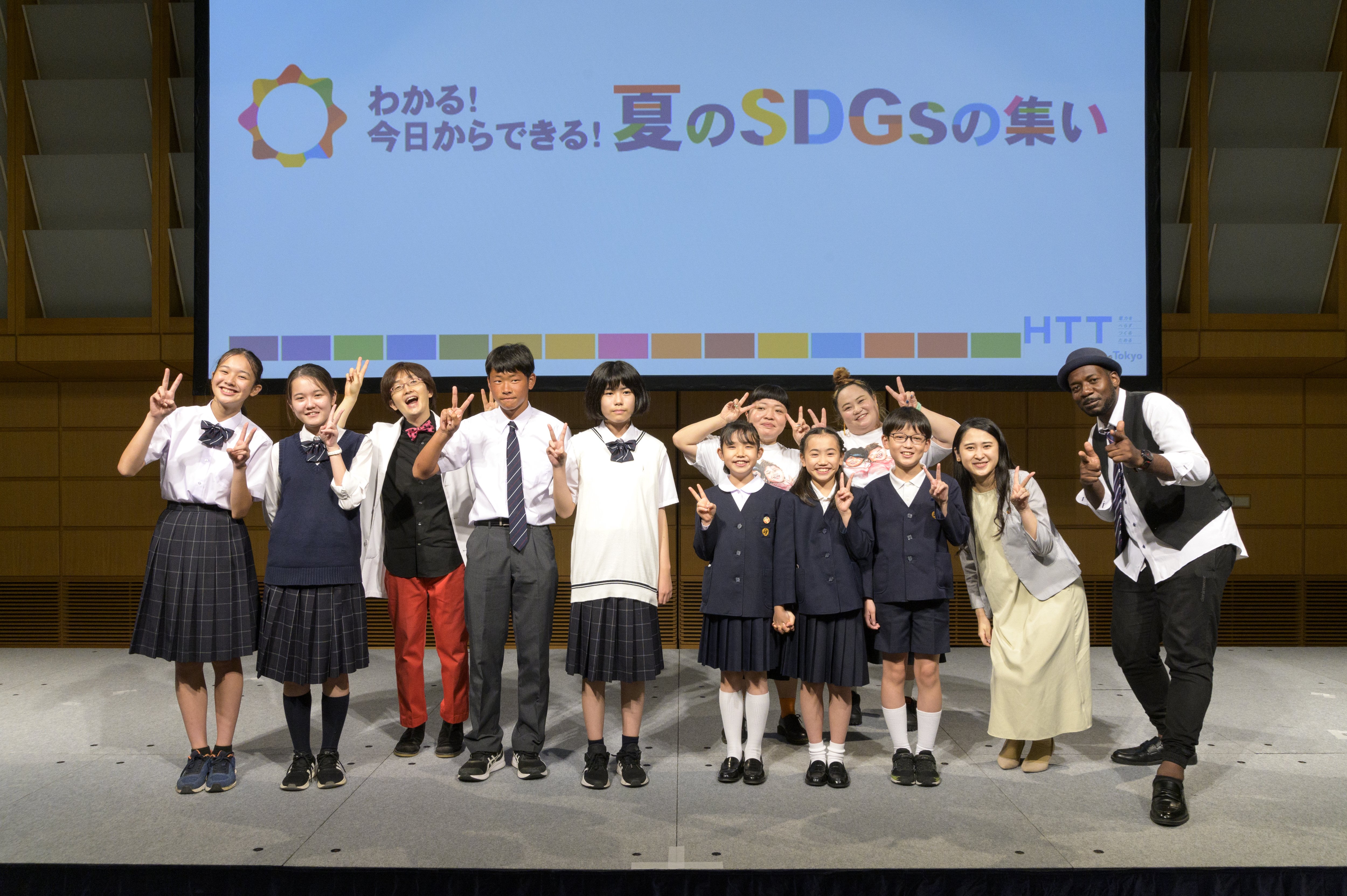
【イベント名】【わかる!今日からできる!】夏のSDGsの集い」
【日時】 令和4年8月20日(土曜日) 13:30-15:00(開場13:00)
【会場】 東京国際フォーラム B5ホール
【主催】 東京都
<概要>
SDGs、最近よく耳にするけれど、どんなものかよくわからない、今さら聞けない、すごく大きいテーマで何ができるのかわからないと、お思いの方も多いのではないか。今日は、とにかくわかりやすく、楽しく、SDGsについて、学ぼう。今日からできることもたくさんある。小・中学生の皆さんは、SDGsを学んでいると思うが、それを発展させていくためのヒントが満載。
今も、私たちは、新型コロナの流行の中にいる。また、最近では必要な電気が足りなくなるかもしれないという問題も出てきている。みんなで一緒にこうした危機を乗り越え、持続可能な都市を創り上げたい。電気を減らす、造る、蓄める。HTTの取り組みも、その一環である。未来を担う皆さんがこのイベントをきっかけに、ご家族と一緒に今日からできる取り組みを始めていくことが大事。何事も楽しむことが持続可能。つまり、長続きのコツである。
登壇:黒ラブ教授 芸人 吉本興業
東京大学大学院客員研究員
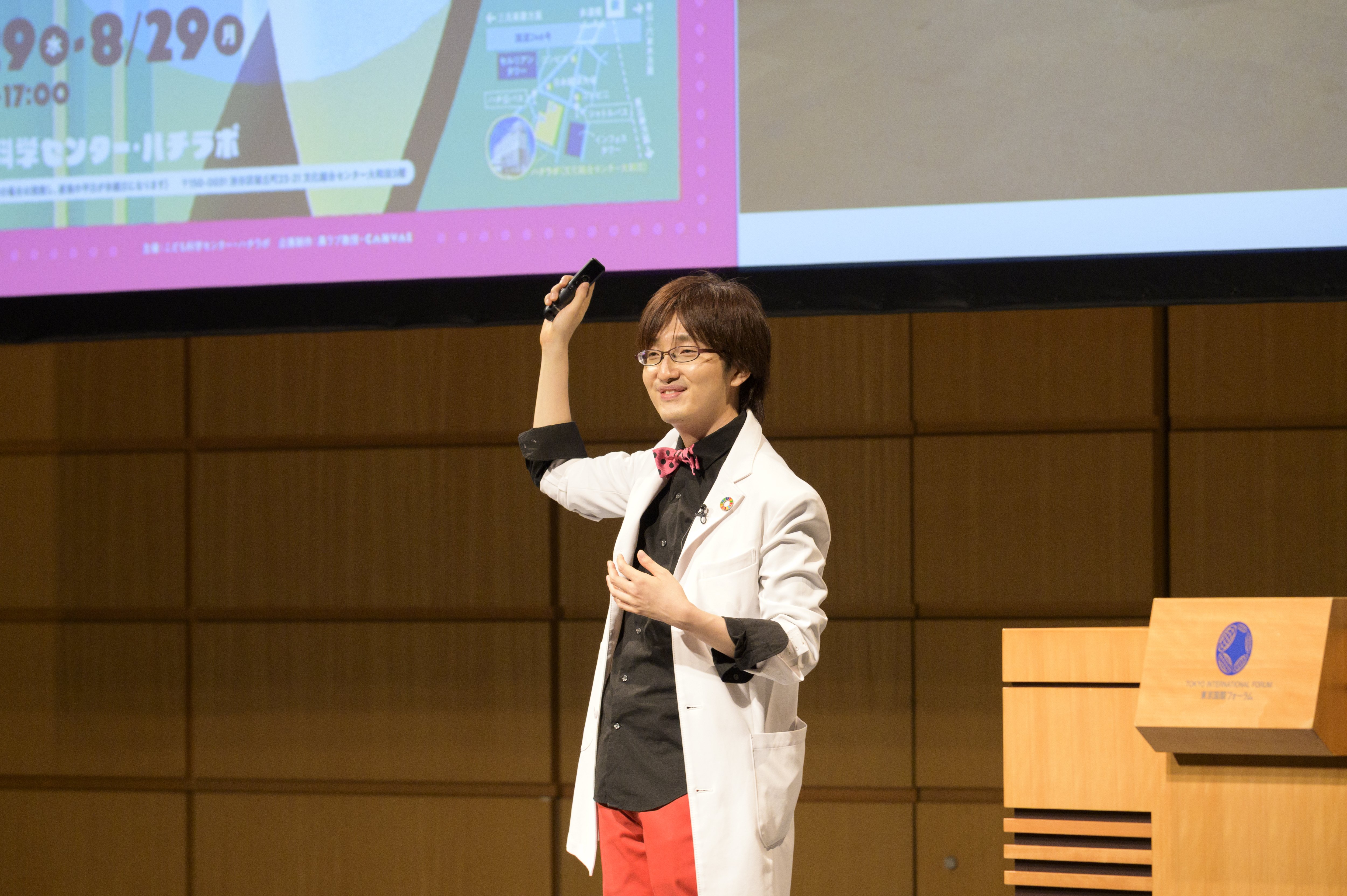
<概要>
SDGsとは、「Sustainable Development Goals」の略称で、長く続く開発発展目標にしようという意味である。後先考えずに工事したから地球が汚れてしまった。そのため、これから工事をするけども、綺麗にしていこうよとそういうのが、SDGsの目標である。Sustainable「長く続くように」というのがポイント。2030年までに世界を良くするための目標として17個掲げられた。今までMDGsというのが進められていたが、これはボランティアベースのため、進みが遅かった。
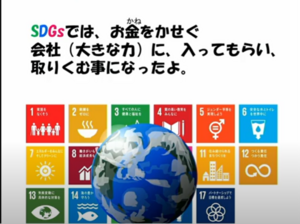
そのため国連は、ボランティアではなく、企業や会社が主体となって、お金を稼ぐ会社に入ってもらって取り組むようになった。さらに、今SDGsに取り組むと、会社の価値も上がるようになった。そのため、企業も環境に良いことをやりたいとなってきている。一方で、個人としてどのようにSDGsに関わっていくのがいいのだろうか。それは、「買う商品を選ぶ」ということである。企業がSDGsに関わることで、エコな商品が生まれ、それを消費者が選んで買う。SDGsを達成できるかどうかというのは、我々次第だ。
登壇:中央区立月島第二小学校
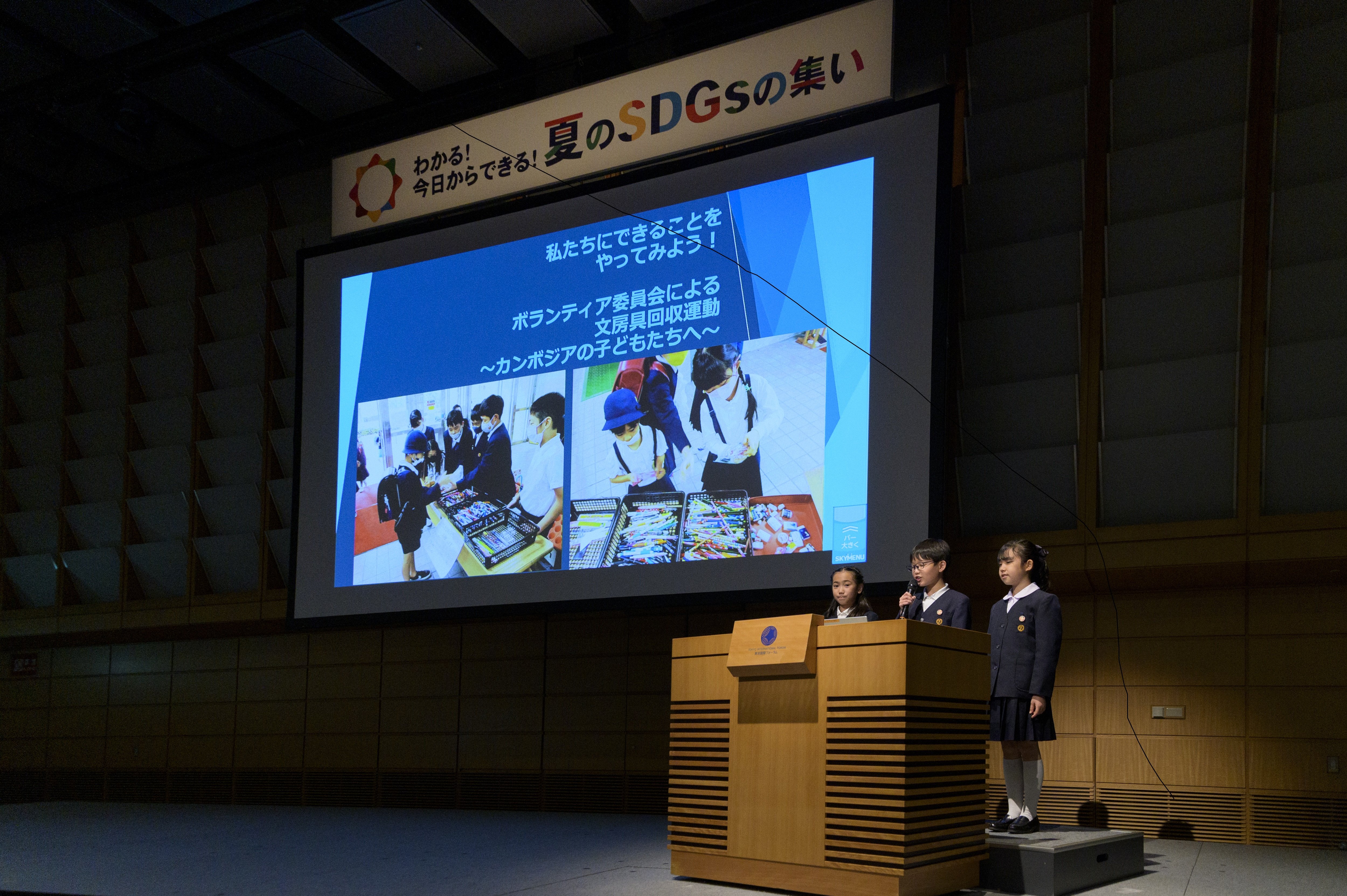
<概要>
月島第二小学校では4つの取り組みを行っている。
基本的な衛生施設を使えない人が世界に約20億人いるということを知り、一人一人の力は小さくても、必ず大きな力になると信じて、ユニセフ募金活動に参加した。また、ユニセフ募金活動の他に使わなくなった文房具の回収も行っている。見たことも会ったこともない遠い国の友達の役に立てたらと切に願う。
家庭からの排水や産業廃水が未処理のまま、川や海に垂れ流しになっているため、海洋汚染が進んでいる。海が汚くなることで、さまざまな生き物に影響を及ぶが、その影響を受ける生き物の一つが魚である。魚にとっては何もしていないのに、住む場所が汚くなるだけでなく、住む場所がなくなっていき、仲間や家族を失うという悲しい事態になっている。そこで、私たちにできることはないかと考え、8月2日から2泊3日で行った臨海学校でゴミ拾いを行った。房総半島の南東京湾に面する館山の海には、海水浴場よりも海の中にたくさんのプラスチックゴミがあることに驚いた。
夢の島はあと50年でゴミが入り切らなくなってしまう。そう簡単に埋め立て地を増やすことはできず、私たち一人一人がゴミを減らすことを心がけて生活する必要がある。3Rではもう間に合わないため、今は5Rが推進されている。月島第二小学校の5Rのうち、リデュース・リユース・リペア・リサイクルの4つの取り組みを行っている。
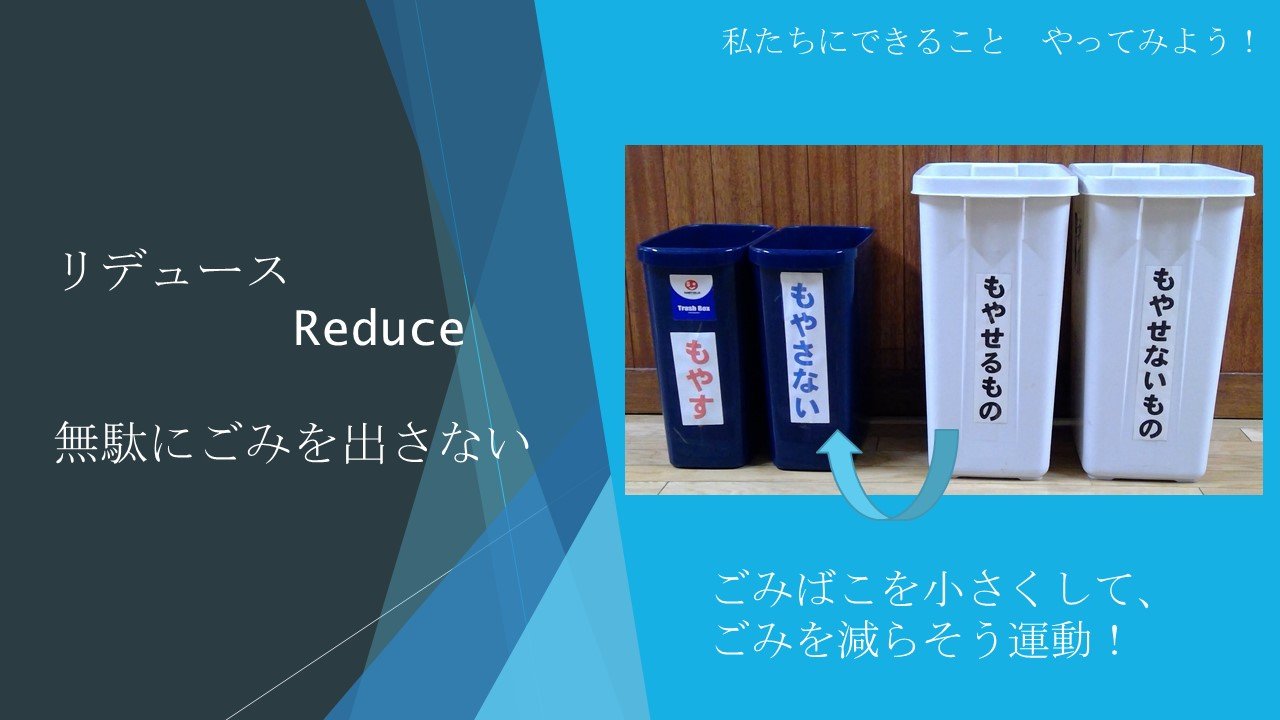
月島第二小学校では、ジェンダー平等を目指す取り組みとして、今年の6月から男女問わずスカートやズボンを選んで着用できるようになった。選択肢が増えたことで、ズボン着用する児童が増えるのではないかなと思う。今回、SDGSを通して学んだことを多くの人に広めていくことが僕たちの役割だ。自分だけ良ければ良いという考え方ではなく、常に周りに目を向けていけたらなと思った。僕たちはスタートラインに立ったばかり。2030年向け自分たちにできることをやっていく。
登壇:多摩市立聖ヶ丘中学校
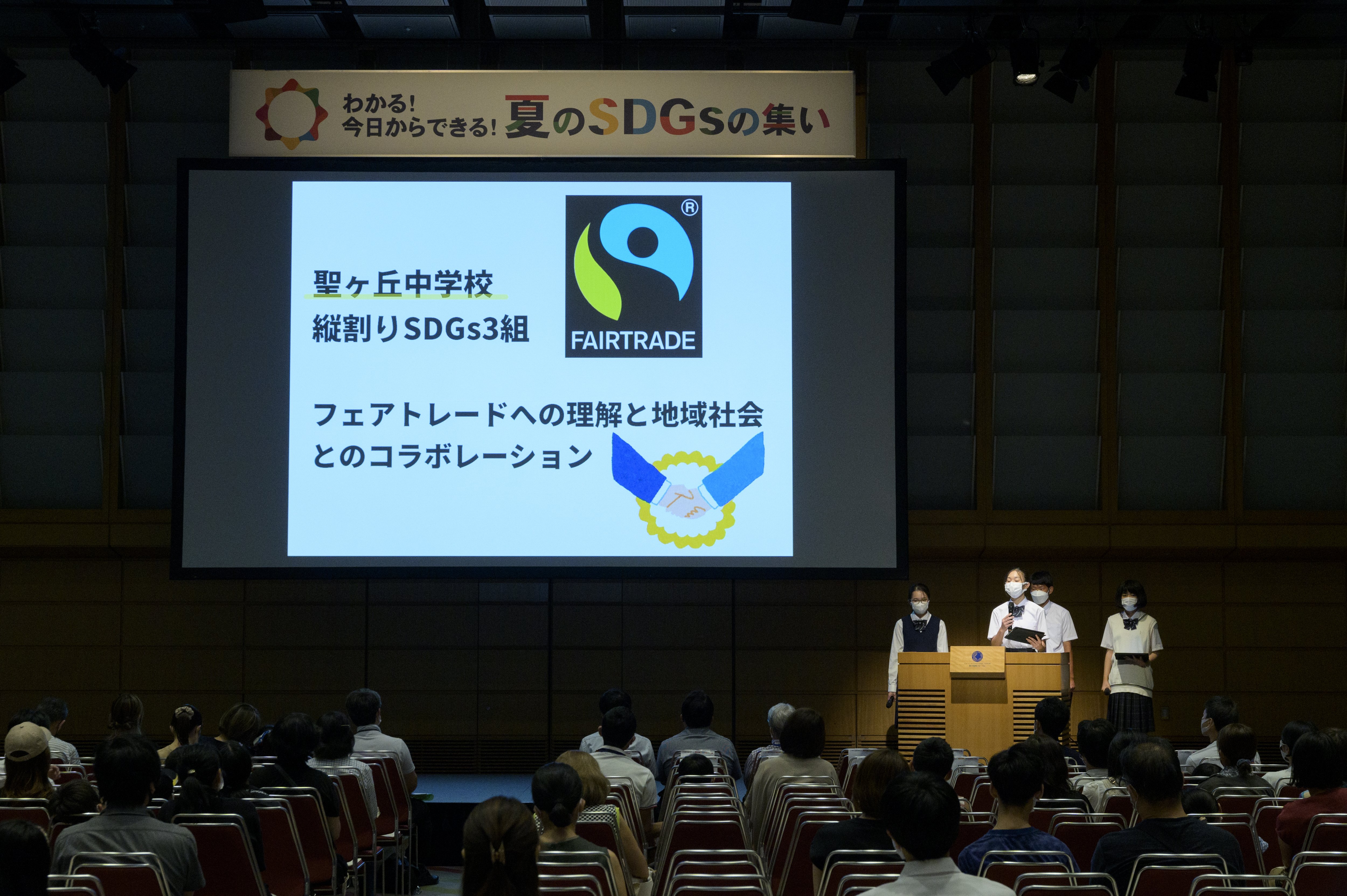
<概要>
アートマイルと、1から3学年をクラス単位で縦割りにして行ったSDGsの活動について紹介する。
アートマイルとは、海外校と貧困や環境などの世界共通の課題について、対話的・共同的に学び合い、学習の成果として世界に訴えるメッセージを込めた壁画を共同作成するプロジェクトのこと。私たちは、インドネシアの学校と質の高い教育とは何か。それを実現するためにはどのような心がけが大切かをテーマに、この活動を行った。
1組は地域清掃及び野菜栽培販売を行った。私たちは、まず貧困をなくそうというテーマをもとに、ユニセフに寄付をすることにした。しかし、ただ、ユニセフに寄付するだけではなく、何かを作って販売し、発生したお金で寄付をしようということになり、そこで、大根とパンジーを植え育てることにした。地域清掃を行い、堆肥を集めることでSDGsの7番に貢献したり、地域清掃によって町をきれいにすることで11番に貢献したり、地域清掃をみんなで行うことで17番に貢献したりなど、さまざまなことができた。
2組では、不要な布を再生するプロジェクトを行った。SDGsの活動の一環として、ごみの削減を目的に不要な布をコースターにリメイクした。また、SDGsへの貢献のため、共同で作業する連帯感を養うことを目的・目標とし活動した。私たちは地域から不要な布を回収、分別した後、協力して布を切り取り、布のアイロンを行った。その後布を縫い合わせ、コースターを作りあげた。
3組では、フェアトレードへの理解と地域社会とのコラボレーションをテーマに、フェアトレード商品の広報活動を行った。フェアトレードとは、生産者と先進国の消費者が対等な立場で貿易を行う。日本では途上国で生産された日用品や食料品が驚くほど安い価格で販売されていることがある。一方、生産国ではその安さを生み出すため、正当な対価が生産者に支払われていなかったり、生産性を上げるために必要以上の農薬が使用されて環境が破壊されていたり、生産する人の健康に害を及ぼしたりといった事態が起こっている。そこで、フェアトレードの認知度を上げる取り組みとして、POPやポスターの作成や、放送・認知度アンケートを行った。これからも私たちにできることは何かを考え、これまでの取り組みを生かした持続する活動をしていきたい。
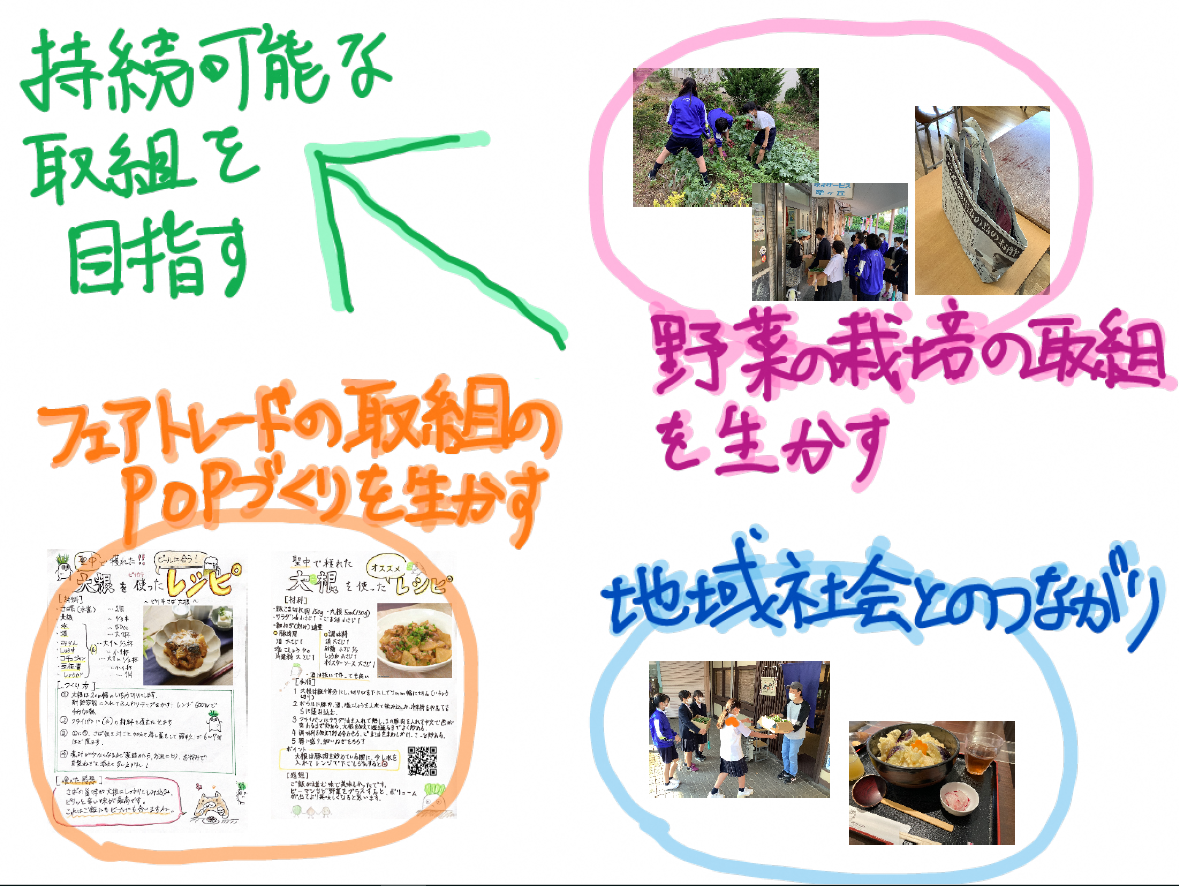
パネリスト:
神山治之 フードバンクTAMA理事長
星野ルネ カメルーン出身 漫画家
大塚桃奈 上勝町ゼロ・ウェイストセンターWHY
モデレーター:
和田恵 ㈱大和総研研究員
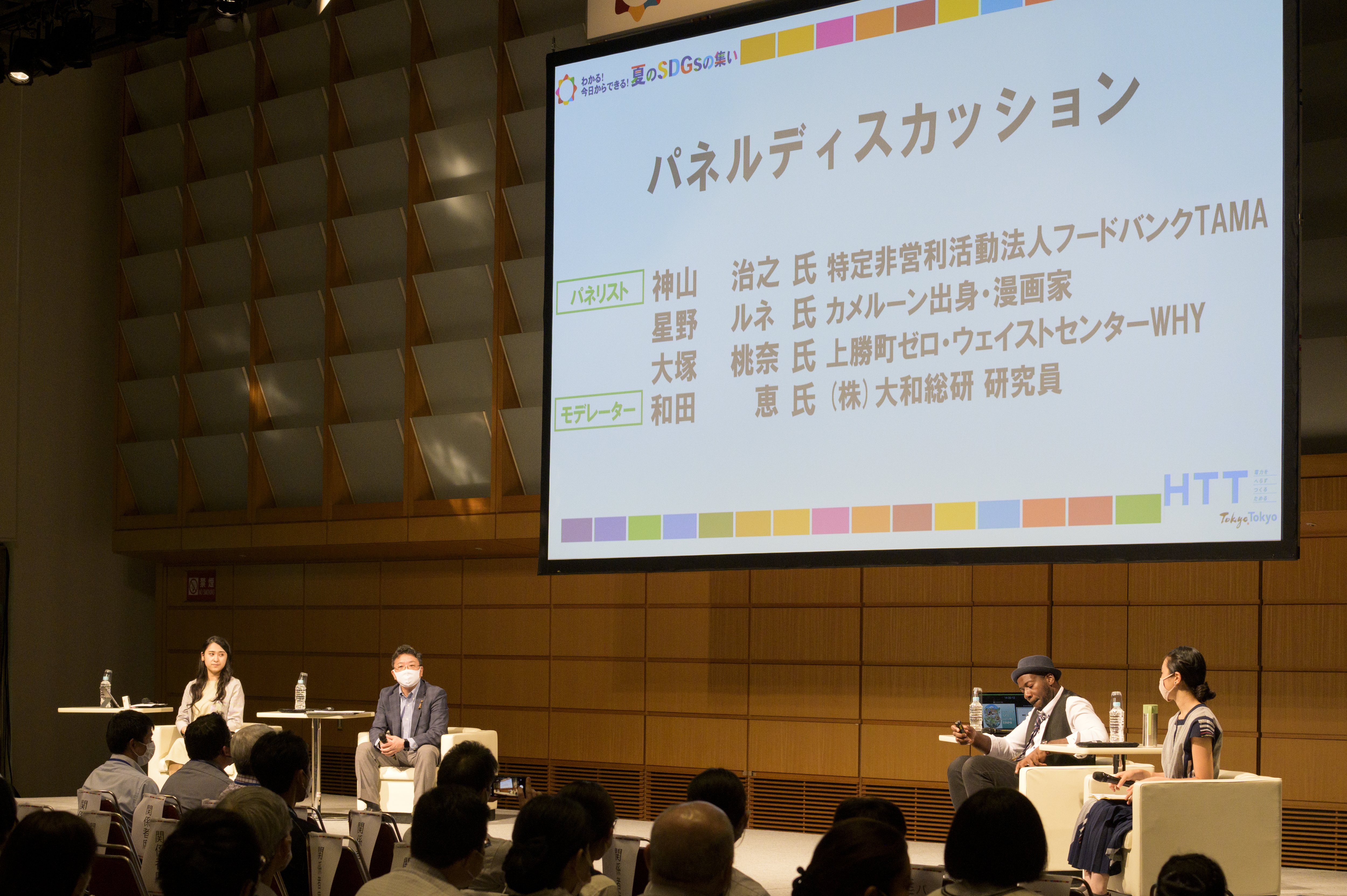
パネルディスカッションの様子
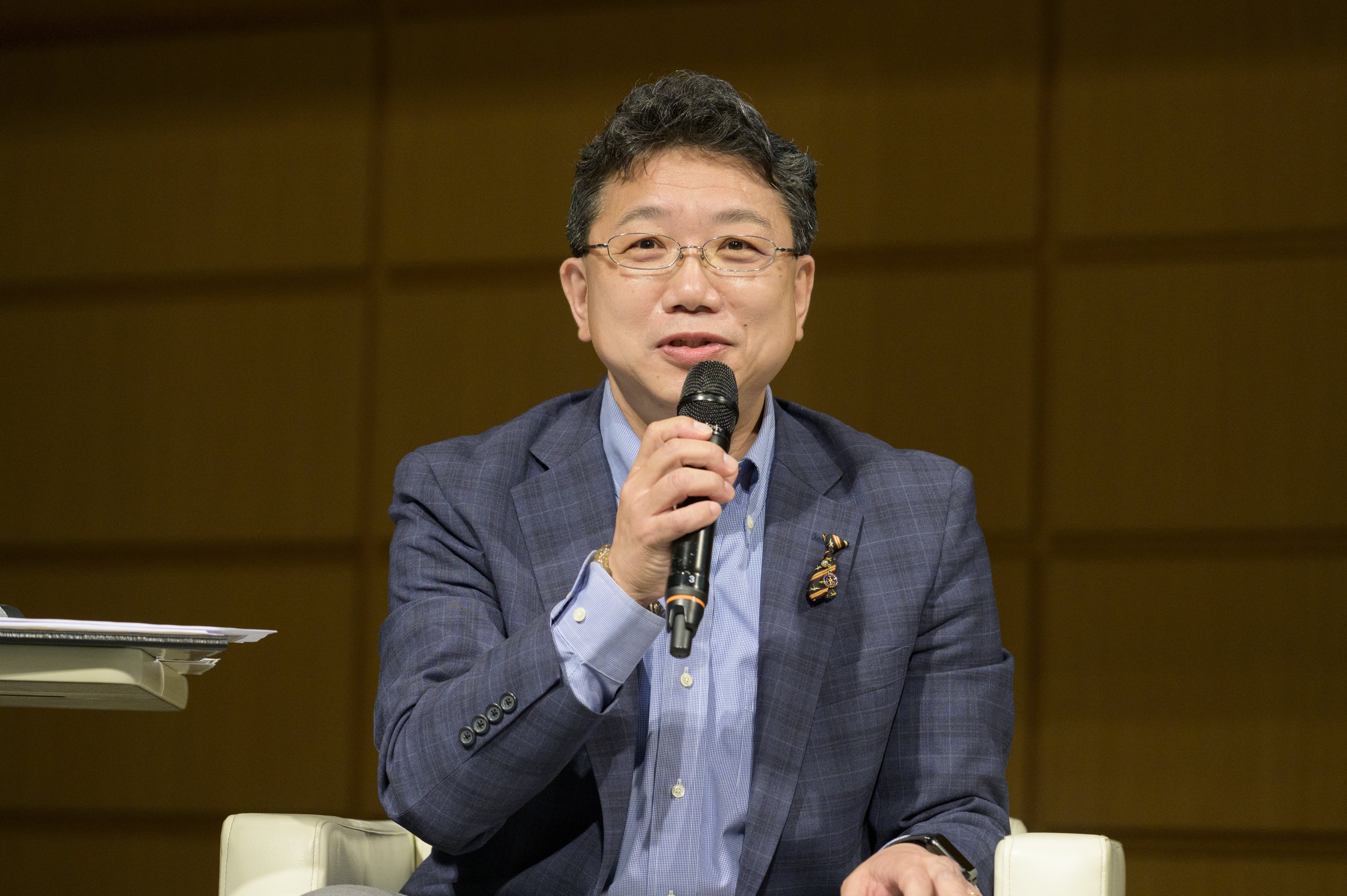
神山氏
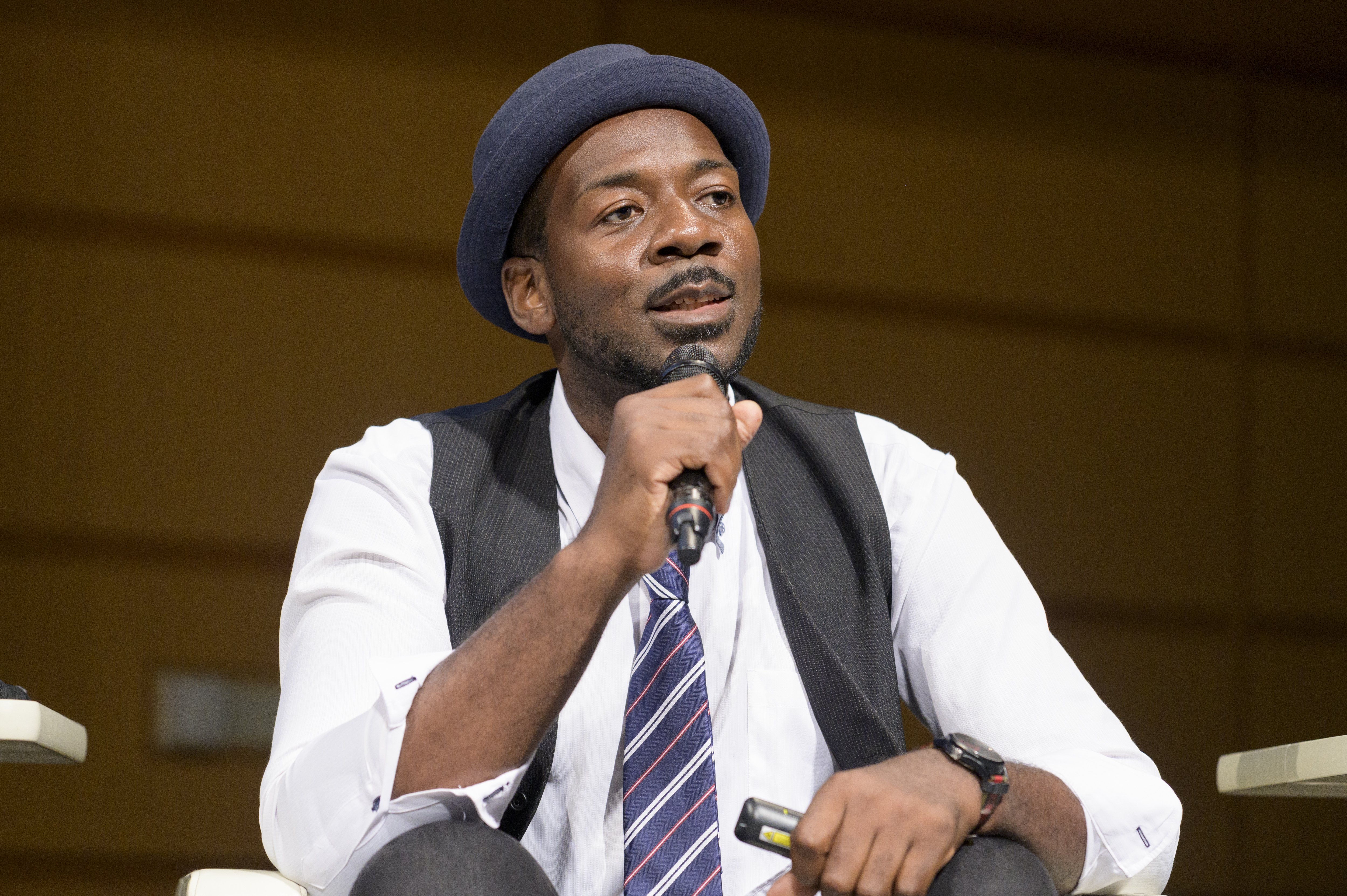
星野氏
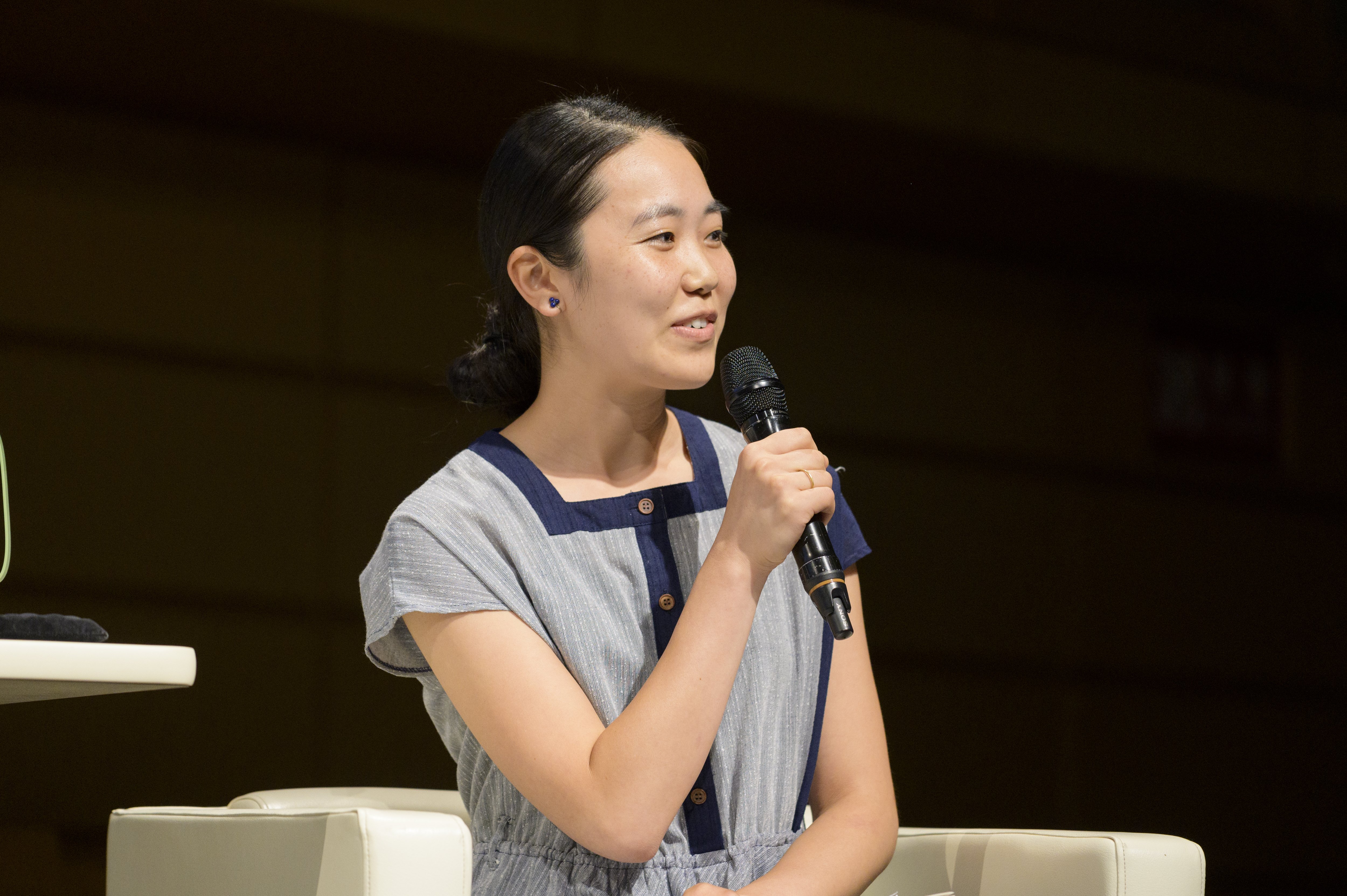
大塚氏
【和田氏】
東京都では、小学生・中学生の皆さんに、未来の東京について一緒に考えてもらえるよう、SDGsを切り口として「『未来の東京』戦略」を説明する動画を作成した。動画を視聴し、アンケートにより「未来の東京」についての意見を集めている。その設問の1つに「1つ願いがかなうなら、「未来の東京」をこうしたい!」という問いがある。子どもたちからは、「安心安全で誰もが生きやすい社会」、「自然豊かな街」といった様々な回答をいただいた。登壇者に同じ質問をさせていただく。
【参考リンク】
【神山氏】やはり貧困問題だったり、格差だったり、これがなくなるとはなかなかないかもしれませんが、少しでも減らしていきたい。
【星野氏】いろんなバックグラウンドやルーツを持った人が、また誰しもが自然に生きていける。そんな未来だったらいい。
【大塚氏】ごみのない社会を未来につくっていきたい。例えば、意識しなくとも、循環の選択肢が日常の中で選べたり、ごみが価値に変わったり、そんな社会がいい。
【神山氏】世界では年間13億トンものまだ食べられる食料品が廃棄され捨てられている。賞味期限が過ぎたから捨てるけど、まだ本当は食べられるものだからもったいない。これをよく考えて無駄も少なくしていきたいと考えている。企業は作り過ぎたものや、中身には問題ないけど箱が潰れたものを捨てています。また、ご家庭の食べ残しや買ったけど調理しないものもロスになっています。私たちはそういった食料品を預かって無料で配る「フードバンク」や、一人親家庭や少し生活が苦しい家庭などを対象にして、フードバンク団体が集めた食料品を無料で渡す「フードパントリー」、食べられるのに、食べる人がいない、お土産でたくさんもらったけど、食べきれない、そうした食料を集める「フードドライブ」など、様々な活動を行っている。本日集まってくれた皆さんに、事前に家にある食料をチェックする、食品を適切に保存する、食材を上手に使いきることをお願いしたい。皆さんが少し気にするだけで、食品ロスは一歩前進する。
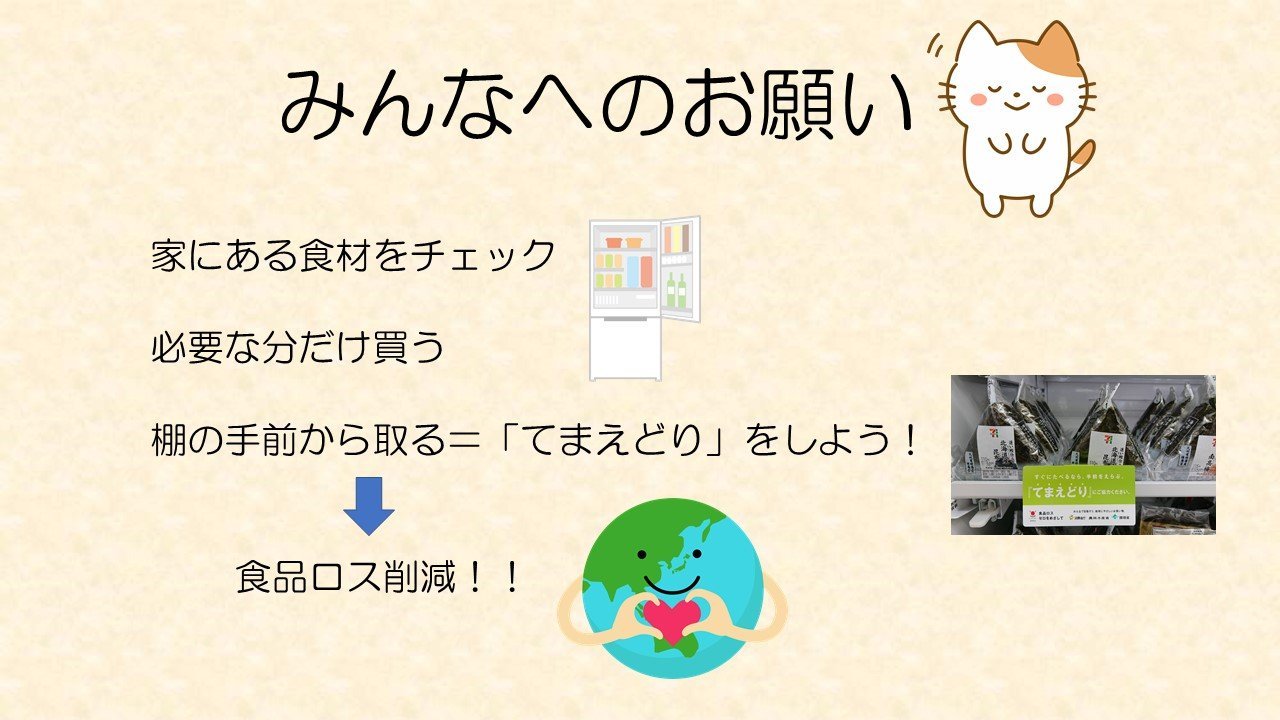
【星野氏】日本人かどうかそれも大事だが、その人生が日本と深く繋がっている人、ここをみんなもっと考えてみてどうかと。日本人と外国人の2つの軸でしか考えたことがない人も多いが、実は日本と繋がっている人が様々な形でいる。日本の中で、日本人もたくさんいる、日本人じゃない人も住んでる。みんなが同じ地域の中でどうやって助け合って、違いを乗り越えながら生きていくかっていうのがすごく大切だと思う。違いがあると、人間同士は喧嘩したりぶつかったりすることもあるけど、何か新しいアイデアや、新しい発明、カルチャーやエンターテインメントが生まれるときは、 違う人がいっぱい集まっているとき。違いを乗り越えるのは大変だが、乗り越えた先にいいものができるのが多様性がちゃんとある社会だと思う。そういう社会をみんなで作っていけばいいのではないかと思う。
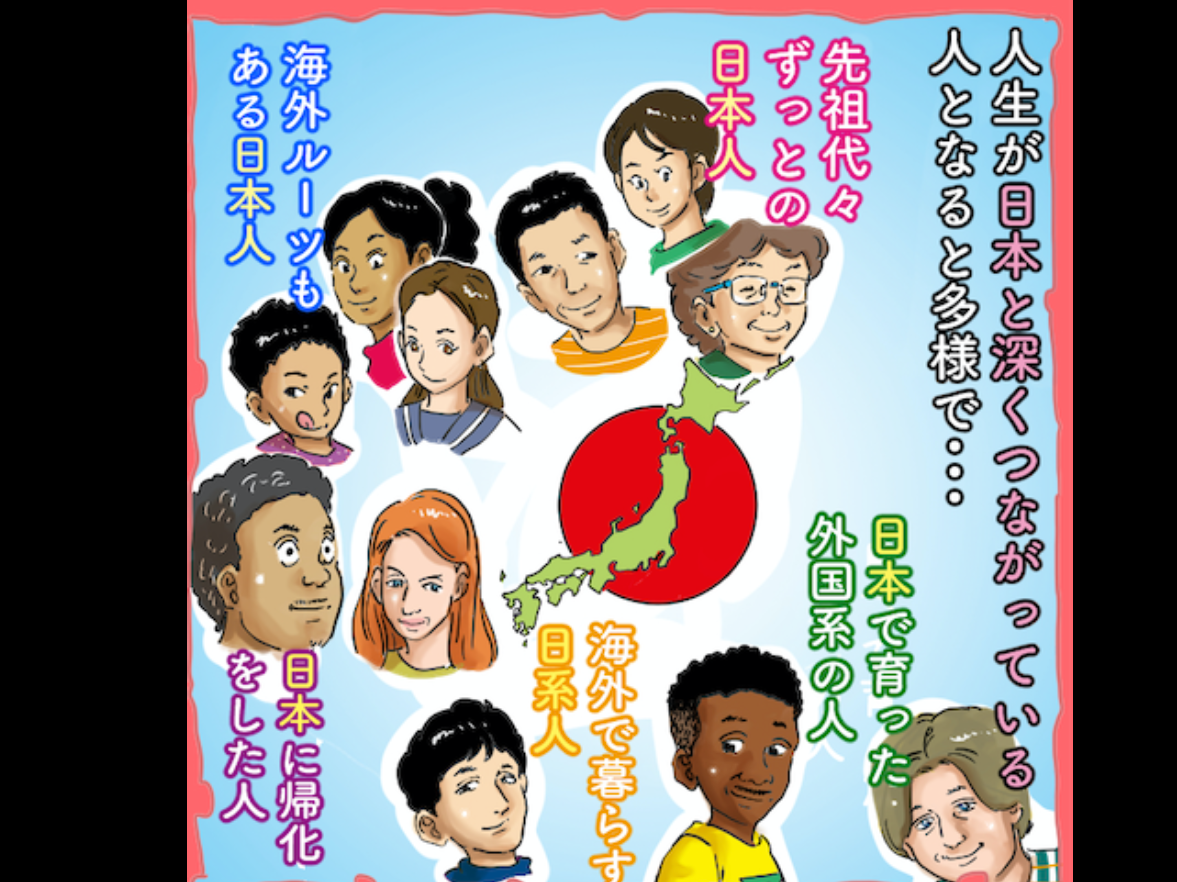
【大塚氏】いろんな資源を使って地球からの恵みを受け取って物が形作られている。でも、それを簡単に捨てることができてしまう社会が今の世の中である。日本は日本の大きさ約1.7個分の日本の資源を使っていると言われている。それを約80%は焼却処分をして、いろんな資源を使いお金やエネルギーをかけてモノを作っているけれども、それを同じくエネルギーとお金を使ってモノを捨てている。臭い、汚いなどとてもネガティブなイメージをゴミに対して持たれる方が多いと思うが、ゴミってクリエーティブで楽しいことだと感じてほしい。ゴミを資源と捉えて、その資源をきちんと自分自身や社会の中で管理をしていくことが大切だと感じる。私たちが運営する、上勝町ゼロ・ウェイストセンターWHYでは、ゴミを畑などの堆肥にしたり、リサイクルする先を見せたりすることで自分のアクションがどこに繋がっているのかが見える。また、未利用の食材を使って、ビールを作って販売している。このように楽しいという体験が大切なことではないだろうか。
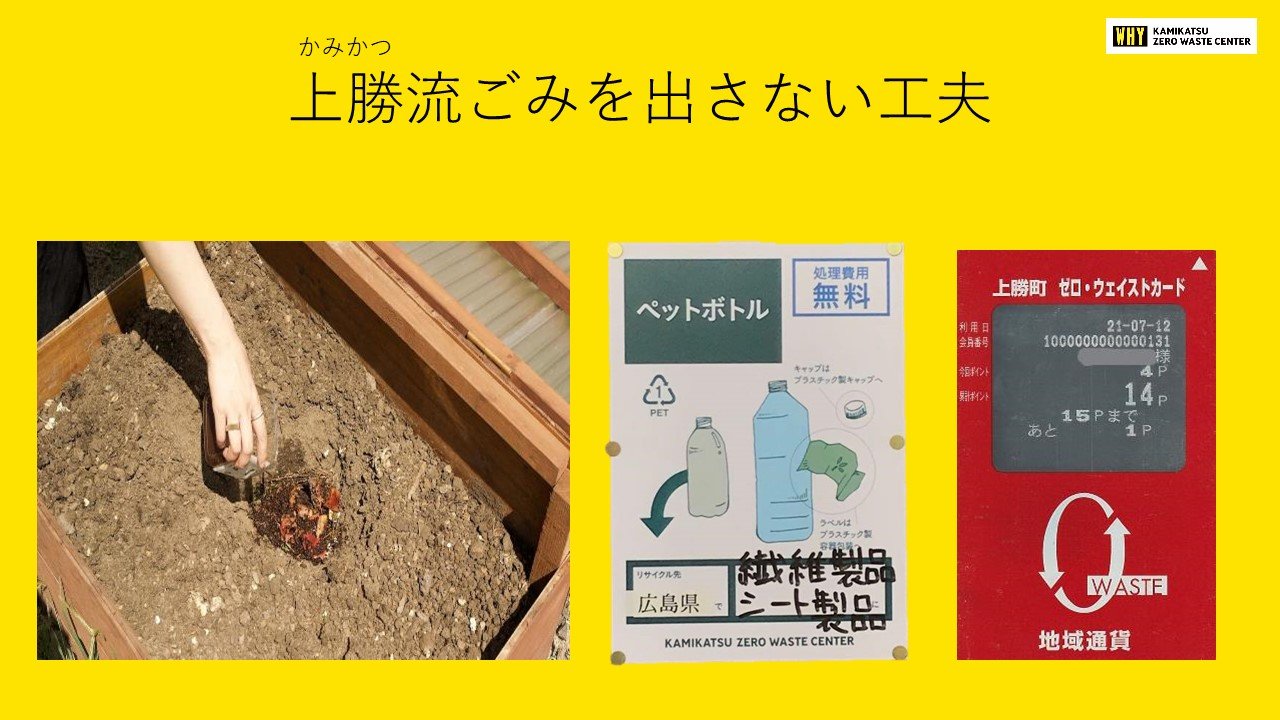
<質問>
今回さまざまな知見から消費者や生活者が身近にSDGsに貢献する方法について教えていただいた。たくさんのアクションがある中で、どれから優先してやればいいのか。ぜひ今日からできるようなアクションがあればご紹介いただきたい。
<回答>
【神山氏】食品ロスについて、やはり残さず食べ切る。買いすぎない。あれもこれも欲しいって思うけれども、やはり今日食べきれるものだけ買うのでもいいのではないか。
【星野氏】自分の地域にいる、外国の人がやっているお店にご飯を食べに行き、色んなお話を聞いてみる。お話ししたことがなかった人と話すのがいい。日本語を話せる外国の人は、日本に結構いる。日本語で話しかけるとちゃんと返してくれる。いろんなお話をして、自分の世界を広げることが大事。友達にそれを伝えると、世界が広がって面白い。
【大塚氏】なるべくゴミになるものを買わないこと。長く使えるものを選んだりリペアができるものがよい。例えば、今日私は分解できる靴を履いてきた。分解できる靴だとリペアして履き続けられる。日々の中で、捨てないモノを選んで買うことが今日からできること。
登壇:黒ラブ教授、おかずクラブ
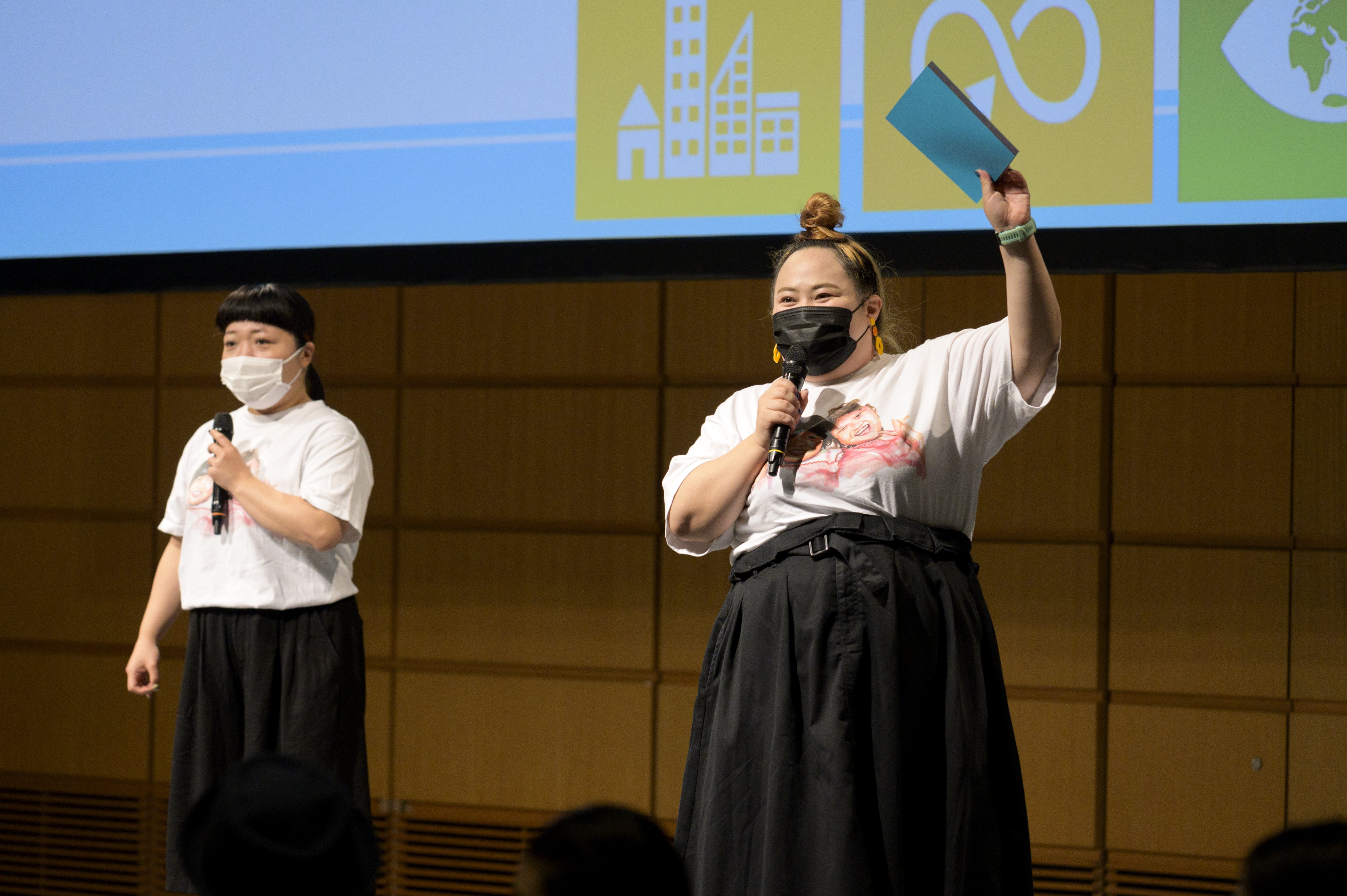
問題1:
「東京都のリサイクル率は何パーセントでしょうか?」
正解:25%
解説:全国平均よりは少しいいけど、まだまだです!先ほどの小学校の発表でもあったけど、東京にはゴミをためておく「ゴミ処理場」が後50年でいっぱいになると言われています。今日からできるSDGsとして、皆さんもゴミをなるべく出さないことや、ゴミの分別を出来るだけしてほしいです。
問題2:
「東京都では、家庭で使われるエネルギーは何パーセントでしょうか?」
正解:30%
解説:実は、家庭からがかなり多いです。工場などは、今、減ってきています。だけど、家庭はあまり減ってないです。都民一人ひとりの省エネ・節電しようと思うことが大切です。テレビやエアコンの付けっぱなしにしない、シャワーを出しっぱなしにしないなど、生活の中でできる省エネ・節電はたくさんあります。みんなで気にしていきましょう!
夏のSDGsの集いが「TOKYO UPDATES」という東京都の魅力を伝えるオンライン・マガジンの記事になりました。以下のタイトルまたは画像をクリックしてご覧ください。
On August 20, 2022, the Tokyo Metropolitan Government held an event for Tokyo residents to learn about the SDGs in a fun way. Let's use this page to learn tips on how to tackle the SDGs and start putting them into practice starting today!

【Event Name】 "Summer SDGs Gathering"
【Date】 Saturday, August 20, 2022 13:30-15:00 (venue opening 13:00)
【Venue】 Tokyo International Forum, Hall B5
【Organizer】 Tokyo Metropolitan Government
<Summary>
Many of you may have heard the term "SDGs" a lot lately, however, you may not be familiar with what they are, you
may
not be able to ask about them at this late stage, or you may not know what you can do about them because they are
very big themes. Today, let's learn about the SDGs in a simple and fun way. There are many things you can do
starting today. I believe that elementary and junior high school students are learning about the SDGs. Today's event
is full of tips for developing them.
Even now, we are in the midst of the COVID-19 pandemic. There is also the recent concern that we may not have enough
electricity to meet our needs. Together we would like to overcome these crises and create a sustainable city. HTT
initiatives to reduce, produce, and store electricity are part of this effort. It is important that all of you, the
future leaders, take this event as an opportunity to start initiatives that you can take starting today with your
families. The key to sustainability, or longevity, is to enjoy everything.
Speaker: Mr. Kuro Love Kyouzyu, comedian, Yoshimoto Kogyo Holdings Co., Ltd.
Guest Researcher, Graduate School of
the University of Tokyo

<Summary>
SDGs stands for "Sustainable Development Goals" which means to make them long-lasting development goals. The earth has been polluted because of construction without thinking of the consequences. Therefore, the goal of the SDGs is that we are going to do construction but let's keep it clean. Sustainable "for the long last" is the key. Seventeen goals were set to improve the world by 2030. In the past, MDGs were promoted, but this was volunteer-based and progress was slow.

For this reason, the United Nations began to take the initiative and have companies and firms that earn money come in and work on it, rather than volunteers. Furthermore, working on the SDGs now also increases the value of the company. As a result, companies are becoming more willing to do what is good for the environment. On the other hand, how can we as individuals get involved in the SDGs? It is a matter of "choosing the products to buy". When companies get involved in the SDGs, eco-friendly products are created, which consumers then choose to buy. It is up to us if we can achieve the SDGs or not.
Speakers: Students of Chuo city Tsukishima No.2 Elementary School

<Summary>
Tsukishima No.2 Elementary School is implementing four initiatives.
Knowing that there are approximately 2 billion people in the world who do not have access to basic sanitation facilities, we joined UNICEF fundraising activities, believing that even though each person's power may be small, it will surely be a great help. Additionally, we collect stationery that is no longer in use. We sincerely hope to be of help to our friends in far away countries that we have never seen or met.
Wastewater from households and industrial effluents are left untreated and dripping into rivers and oceans, resulting in marine pollution. The pollution of the ocean affects a wide variety of creatures, and one of those affected is fish. It is a sad situation for the fish, who have done nothing but getting dirtier and dirtier where they live, and are losing their friends and family as they lose their homes. So, we wondered if there was anything we could do to help, and we picked up garbage during the three-day, two-night seaside school that began on August 2. We were surprised to find more plastic garbage in the sea at Tateyama, which faces the South Tokyo Bay on the Boso Peninsula, than at the beaches.
The " Yumenoshima" will not be able to hold more garbage in another 50 years. We cannot add more landfill space so easily, and each of us needs to be mindful of reducing waste in our daily lives. The 5Rs are now being promoted because the 3Rs are no longer enough. Tsukishima No.2 Elementary School is involved in four initiatives of the 5Rs: Reduce, Reuse, Repair, and Recycle.

In an effort to promote gender equality, Tsukishima No. 2 Elementary School has allowed students of both genders to choose and wear skirts and pants since June of this year. We think that more children will wear pants now that they have more options. Our role is to spread what we have learned through the SDGs to as many people as possible. We wished we could always look around us instead of thinking that it is good only for ourselves. We have just started, and we will do what we can do for the year 2030.
Speakers: Students of Tama City Hijirigaoka Junior High School

<Summary>
The "Art Mile" and the SDGs initiatives that were carried out by groups of classes with the same number in the three grade levels will be presented.
"Art Mile" is a project in which students learn about issues common to the world, such as poverty and the environment, in an interactive and collaborative manner with schools overseas, and as a result of their learning, jointly create a mural with a message that appeals to the world. We conducted this initiative with Indonesian students, focusing on the theme of what quality education is and what kind of mindset is important to achieve it.
Class #1 did a community cleanup and grew and sold vegetables. We decided to make a donation to UNICEF based on the theme of eliminating poverty first. However, instead of merely donating to UNICEF, we decided to make and sell something and donate the money generated to UNICEF, and decided to plant and grow radishes and pansies. By collecting compost, we could contribute to SDG #7, by cleaning up the town through community cleanups, we could contribute to SDG #11 and #17, and so on.
Class #2 conducted a project to recycle unneeded cloth; as part of SDGs initiatives, we remade unneeded cloth into coasters with the aim of reducing waste. In addition, activities were conducted with the objective and goal of fostering a sense of solidarity to work together in order to contribute to the SDGs. We collected and sorted unwanted cloths from the community, then worked together to cut and iron the cloths. The textiles were then sewn together to create coasters.
Class #3 conducted a publicity campaign for fair trade products with the theme of understanding fair trade and collaborating with the local community. “Fair trade” is trade between consumers in developed countries and producers on an equal footing. On the other hand, in the producing countries, in order to realize such low prices, there are cases where producers are not being paid fair compensation, where the environment is being destroyed by using more pesticides than necessary to increase productivity, and where the health of the people who produce the food is being harmed. Therefore, in an effort to raise awareness of fair trade, we created POPs (Point of purchase advertising) and posters, and conducted advertising and awareness surveys. We would like to continue to think about what we can do, and to make use of our past efforts to carry out sustainable initiatives.

Speakers:
Haruyuki Kamiyama, Chairman, Food Bank TAMA
Rene Hoshino, born in Cameroon, cartoonist
Momona Otsuka, Kamikatsu Zero Waste Center WHY
Moderator:
Megumi Wada, Researcher, Daiwa Institute of Research Ltd.

Panel Discussion

Mr. Kamiyama

Mr. Hoshino

Ms. Otsuka
【Ms. Wada】
The Tokyo Metropolitan Government has created a video explaining “Future Tokyo: Tokyo’s Long-term Strategy”, using the SDGs as a starting point, so that elementary and junior high school students can think about the future Tokyo together. Students watch the video and then send their opinions about "Future Tokyo" to the TMG through a questionnaire. One of the questions was, "If I could have one wish come true, what would it be for the future Tokyo? The children gave a variety of responses such as "a safe and secure society where everyone can live comfortably" and "a city of abundant nature". I would like to ask the same question to the panelists.
【Reference link】
Future Tokyo Strategy Video (Japanese only)
Future Tokyo Worksheet (Japanese only)
【Mr. Kamiyama】The problems of poverty and inequality may not be easily eliminated, but we would like to reduce them as much as possible.
【Mr. Hoshino】I wish for a future where everyone with various backgrounds and roots can live in a natural way.
【Ms. Otsuka】We would like to create a society without garbage in the future. For example, I hope to see a society where people can choose recycling options in their daily lives even without being conscious of it, and where garbage is transformed into value.
【Mr. Kamiyama】Worldwide, 1.3 billion tons of still edible foodstuffs are discarded annually. Foods past their expiration date are thrown away, but it is a shame because they are still really edible. We want to think this through and reduce waste. Companies are discarding overproduced items or items that are fine on the inside but have crushed boxes. In addition, leftovers from households and items that are bought but not cooked are also losses. We are entrusted with such groceries to carry out various initiatives such as "Food bank" that keeps groceries and distributes them free of charge, "Food Pantry" in which food items collected by food bank organizations are given free of charge to single-parent families and other families that are having a bit of a hard time making ends meet, “Food drive" to collect food that can be eaten but no one will eat, or food that was given as a gift but is too much to eat, etc. My requests to all of you gathered here today are to check the food in your homes in advance, to store food properly, and to use up your food ingredients skillfully. If you all just care a little, we can take a step forward in addressing the food loss problem.

【Mr. Hoshino】I suggest that everyone think more about those whose lives are deeply connected to Japan, rather than whether they are Japanese or not. Many people have only seen people in terms of two axes, Japanese or foreigners, but in fact there are many people connected to Japan in various ways. There are many Japanese, and non-Japanese people living in Japan. I think it is very important how everyone can help each other and live together overcoming differences in the same community. When there are differences, people may fight and clash, but when new ideas, new inventions, culture, and entertainment are born, it is when people from different backgrounds are gathered together. It is challenging to overcome differences, but I believe that a society with proper diversity is able to produce good things after overcoming them. I think we should all work together to create such a society.

【Ms. Otsuka】Things are formed by receiving blessings from the earth using various resources. But we live in a society today where it is easy to throw these things away. It is said that Japan consumes resources equivalent to about 1.7 times the size of the country. Despite the fact that we spend a lot of money and energy to produce things using various resources, about 80% of them are incinerated. We are spending energy and money to discard things. Many people have a very negative image of garbage, such as smelly and dirty, but I want people to feel that garbage is something creative and fun. I feel that it is important to view garbage as a resource and to properly manage such resources by ourselves and society. At the Kamikatsu Zero Waste Center WHY, which we operate, garbage is turned into compost for use in farms and other places, showing what happens after garbage is recycled and where people's actions lead to. We also use underutilized ingredients to make and sell beer. This is the importance of such an enjoyable experience.

<Question>
Today, various findings have taught us how to contribute to the SDGs in our daily consumption and daily life situations. Which of the many actions should be prioritized first? If you have any actions that we can take starting today, we would like to hear from you.
<Answers>
【Mr. Kamiyama】As measures to prevent food loss, it is important to eat up all the food without leaving any leftovers and not to buy too much. We want many things, but it is still better to buy only the groceries we can eat today.
【Mr. Hoshino】You should go out to eat at restaurants in your community that are run by foreigners, and listen to the various stories they have to tell. It is good to talk to someone you have never spoken to before. There are quite a few foreigners in Japan who speak Japanese. If you speak to them in Japanese, they will respond properly. It is important to broaden your world by having a variety of conversations. When you tell your friends about it, the world opens up and it's interesting.
【Ms. Otsuka】It is a tip to not buy things that will be trashed as much as possible. It is advisable to choose one that can be used for a long time or repaired. For example, today I'm wearing shoes that can be disassembled. Shoes that can be disassembled can be repaired and continued to be worn. Choosing and buying things on a daily basis that you don't discard is what you can do starting today.
Speaker: Mr. Kuro-Love Kyouju and Okazu-Club, Yoshimoto Kogyo Holdings Co., Ltd.

Question 1.
"What is Tokyo's recycling rate?"
Correct answer: 25%.
Commentary:
A little better than the national average, but not by much! As was mentioned
earlier in the elementary school
presentation, it is said that Tokyo's "waste disposal plants" for storing garbage will be full in about 50
years. As
a SDGs initiative that you can start today, we hope that you will also try to eliminate garbage and sort
garbage
as
much as possible.
Question 2.
"In Tokyo, what percentage of energy is used by households?"
Correct answer: 30%.
Commentary:
In fact, the percentage of energy consumed by households is quite high. The
percentage of factories, etc., has
been
decreasing in recent years, but not so much for households. It is important that each Tokyo resident is
willing
to
save energy and electricity. There are many energy-saving and power-saving measures that can be taken in
daily
life,
such as not leaving the TV or air conditioner on, or not leaving the shower running. Let's all keep it in
mind!
This event was featured in an article in an online magazine called "TOKYO UPDATES," an online magazine about Tokyo's attractions. Please click on the title or image below to read the article.
"Students in Tokyo Elementary and Junior High Schools Come Up with Their Own SDGs Efforts"